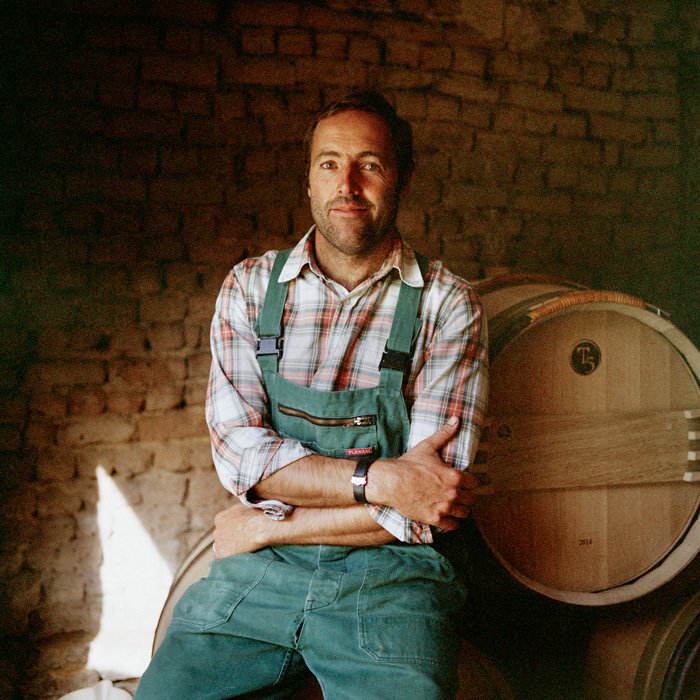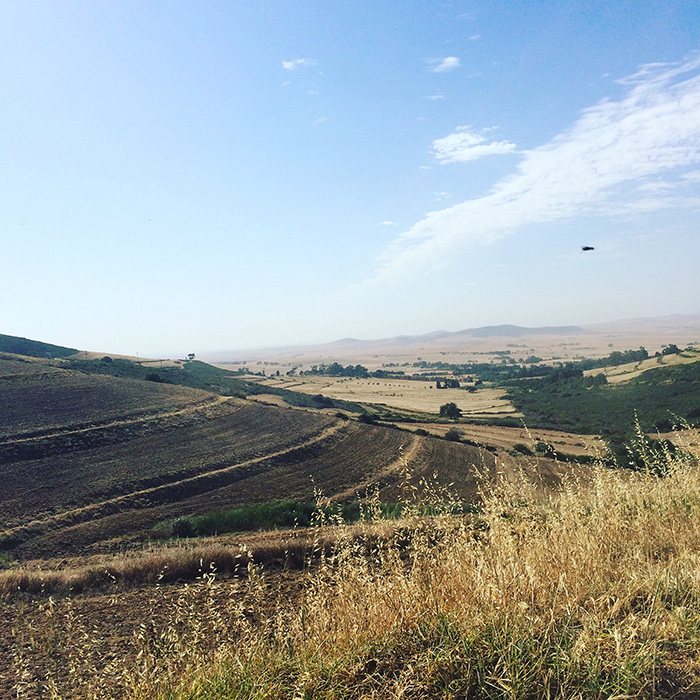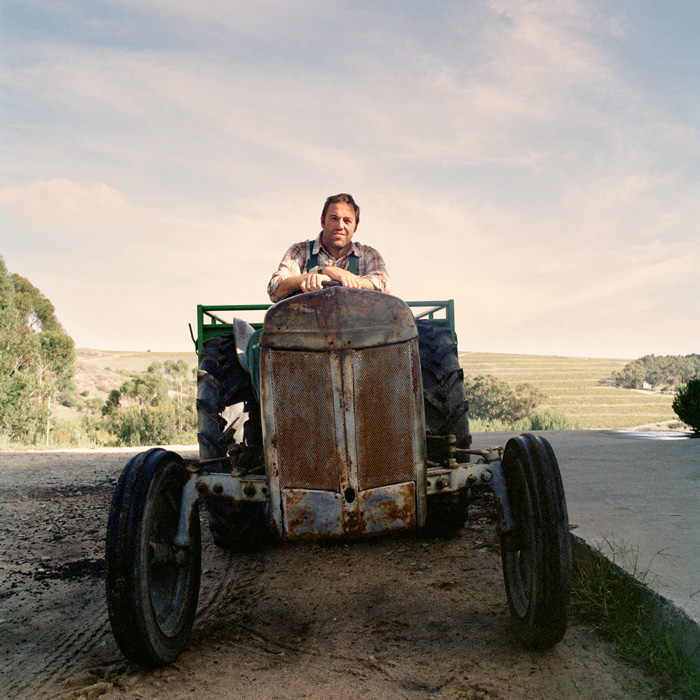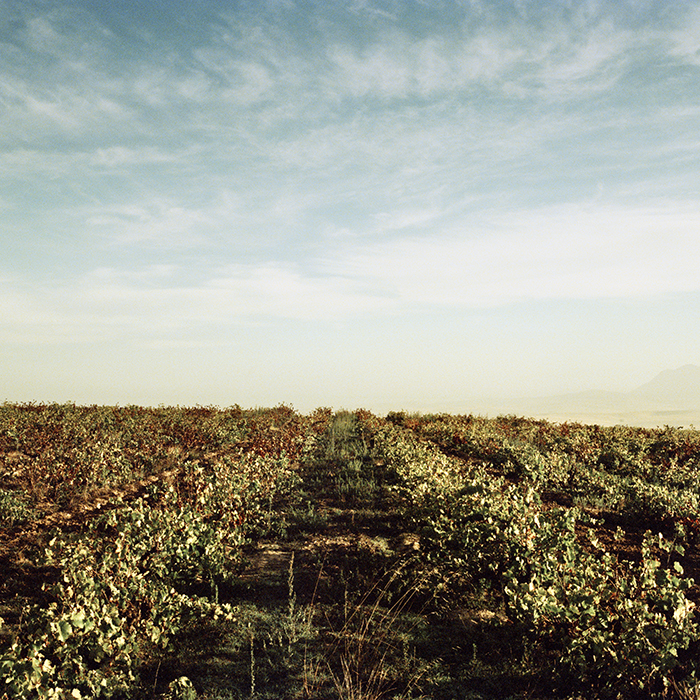Sadie’s success
Author: Sophie Thorpe
Recently back from a trip around South Africa’s winelands, Sophie Thorpe from our Marketing team records an extraordinary visit. There, she met with one of the wine world’s biggest celebrities, and one of the founding fathers of the country’s new wave – Eben Sadie.
I was nervous before meeting Eben Sadie. This is a man who doesn’t do press and doesn’t accept visitors. His winery has no tasting room – but his wines have an intimidating reputation for excellence. Winding along dust-laden dirt tracks, reading Tim James and Platter’s praise for the enigmatic Swartland pioneer, the anticipation only built.
I shouldn’t have worried. As I was to discover during my time in South Africa, the country’s talented winemaking set couldn’t be more relaxed, humble or charming. Eben was no exception to the rule.
A WARM WELCOME
We escaped the already scorching morning sun and ducked into the office. The room reminded me a little of No.3 St James’s Street, the surfaces lined with (regrettably empty) bottles – fabulous vintages of the best wines from Bordeaux, Burgundy, the Rhône and Champagne. Tall, tanned, with a thick accent – Eben shook our hands as he finished off a call, then settled down to tell us about The Sadie Family Wines.
Eben may be the face of the business, but it really is a family company. While we are there his sister Delana arrives with dogs in tow and his mum settles into an armchair nearby to read The World of Fine Wine. Eben smirks: “Next time I open a bottle of Dolcetto she’s going to frown and say she wants the Barolo”.
When we visited at the end of October, he was – like most other producers we visited – pre-occupied by the current season. There had been no rain whatsoever for nine months. “This is the driest it’s been in 89 years,” Eben explains. “So there’s nobody alive and making wine that we can ask about the last drought of this proportion. It’s quite nerve-racking.”
“We’ve got to farm incredibly conservatively this year: it’s like when you run a marathon. You’ve had all the training, but you must also be in the right state of mind, have the proper physique, and the reserves. For the vines this year, it’s gonna to be like running a marathon with a serious hangover and a baby on your back.”
When I asked whether he would consider irrigating this year, knowing that his vines have had under half the rain they would normally receive – he firmly rejected the idea. “There’s something fundamentally wrong with pumping water out of the earth,” he said. “Obviously in a year like this it feels like my philosophy sucks. But, there’ll be rain again. If you have to take one bad vintage in 10 years, but you have a resource that’s intact, that’s better than letting the human greed factor decide where water goes.”
He believes that “water is going to become the most sacred commodity on the planet”. It’s easy to be cynical and see this as theatre – but he’s busy building his first house that will be almost entirely off-grid, with solar panels and a water-collection and purification system. It’s difficult not to be drawn in by this seemingly simple farmer, forgetting momentarily that he makes some of the finest wine in the New World. “I’m made to plant and I’m made to pick. They’re the two things I was grown to do, that’s for sure… and to surf the odd wave,” he says with a smile.
IN SEARCH OF AFRICAN WINE
Talking about the varietals he works with, Eben explains how the New World has been limited. “Europe’s a tiny place, but it has a massive gene pool of plants. However, when we consider the whole New World – New Zealand, South Africa, Australia, South America and North America – we plant seven grapes. Seven. Just seven, irrespective of their affinity, their sustainability, and their sense of belonging. Everyone talks a big terroir game, but how can you say that this wine is an exhibition of this terroir? We’ve taken seven grapes because they fit on excel spreadsheets, they fit on wine lists.”
He is planting tiny quantities (enough for just 80 bottles) of 35 new varieties, on specific sites chosen for their latitude, altitude, radiation and soil affinity. Eben wants to replicate their respective “homes” in Europe as closely as possible. He believes that the New World never evolved, never going through a natural process of selection for the grapes grown.
“So I’m going to plant the lot. And then I’m going to probably have to pull out 90 percent.” He is particularly excited about the potential of Greek varieties, with plantings of Agiorgitiko, Xinomavro and Assyrtiko. He’s also putting in Grillo, Catarratto, Negroamaro, Aglianico, Albanello and Counoise, Terret Noire, Carignan Blanc and Grenache Gris.
This is all in pursuit of an identity, he declares: “We must make African wines – our own wines. We must cut our colonial umbilical cord with Europe.” He believes, in his lifetime, he has “a responsibility to make a wine that resonates this place”, not lesser imitations of France’s finest. Gesturing towards the many bottles around the office, he admits that he had to stop keeping the bottles. “Most of the wine I drink is Burgundy, but it doesn’t mean Burgundy needs to come into my wines in South Africa.”
“One day I hope a Frenchman sits in Burgundy and he drinks our African wine with our African identity and he falls in love with it. It’s a fairy-tale story, but I think it’s possible. I think we can make truly unique wines here.”
THE EVOLUTION OF EBEN
He talks about his journey as a winemaker. After leaving university he made wine by the book, for eight years. Then he veered off-road, making “completely left-wing, off-the-wall natural wines”. He believes that terroir is to be found somewhere in the middle.
“Our wines used to be pitch black; loaded with oak and with massive scores out of 100. They were obvious in what they were, and you didn’t need much of a brain to drink them. They were like vanilla ice cream. Now, 20 years later, our wines are becoming more quiet, more introverted.”
He’s a firm believer that you need a decade of dedication to one thing, one idea. “It’s easy to live off the energy of new things, new creations, new happenings, but you don’t really get closure, you don’t really get the chance to review whether they work or not.”
He recalls a recent visit to Comte Georges de Vogüé in Chambolle-Musigny. “The current generation is the 21st to make wine. I don’t know of any other business in the world that’s got 21 generations, and for all that time they’ve been farming five hectares,” he laughs. “It’s fair to say that they know their five hectares.”
The wines he first dedicated himself to were “regional wines”, Columella and Palladius. “When I want to make a regional wine, I must include all of the region. When you think of a society, you don’t just think of one type of person. No, a society is all of it: the ones that speak softer, the ones that speak louder, it’s the whole thing. And that’s how I see the regional wine: it’s everything.”
LOOKING BACK TO MOVE FORWARD
His next challenge was the “old-vine thing”. To do, this, he sought out parcels of old vines (some dating as far back as 1897) to produce single-vineyard, single-varietal wines – a very pure expression of terroir. “Being a white South African, we don’t like to look beyond 1992,” he says. “On the other side of that date is a lot of bad policy, bad politics, bad everything… But, in that time, also beautiful things happened. We must go back and we must celebrate the beautiful stories, like these old vineyards.”
It looks like the next Sadie experiment will be “African wine”, forming a unique vinous identity for his nation. Part of cutting the “colonial umbilical cord” has been selling his share in a Priorat property, Terroir Al Limit. He has also made the last vintage of his Sequillo wines, his “entry-level” brand that has – in the past – offered access to Sadie’s talent at a lower price point.
So what is he going to do over the next 20 years?
“I want to get better, and not better by the judgement of Decanter or the Platter Guide. I want to get better by our own definition. This way is better for the people that work with us, better for our employees, better for the soils, better for the plants, better for our socio-economics.”
“Everything that needs to happen with our environment: it’s not just in the vineyards, it’s within the whole community.” His two sons will soon be working with him, and he wants to work the land with animals (“for many reasons, not just the poetry,” he qualifies). However the next chapter unfolds, it is bound to be exciting – and no doubt of extraordinary quality.
Explore our complete range of Sadie Family Wines on bbr.com.







I love the Sadie wines….
Thanks for bringing us this wonderful interview! Exactly what an African wine will look like in this day and age remains to be seen! I agree with Eben that not everything pre-92 was bad. We have legendary wines from the 60s and 70s, and probably even earlier. And these wines were not trying to replicate anything from Europe, in fact many was made from our Pinotage grape. It might come as a surprise to some that many of these wines were in fact quite thick, high in alcohol and PH, and hence they kept well. From the early 80’s a lighter style of wine was pursued (earlier picking) and it was a time of experimentation with the introduction of small French barrels. Many wines from the 80s had lower alcohols but tended to be a bit tart. Since the 90’s the focus was on blockbuster wines, extracted, alcoholic and woody. It is only in the last 5-10 years that the natural approach and terroir driven wines became popular.